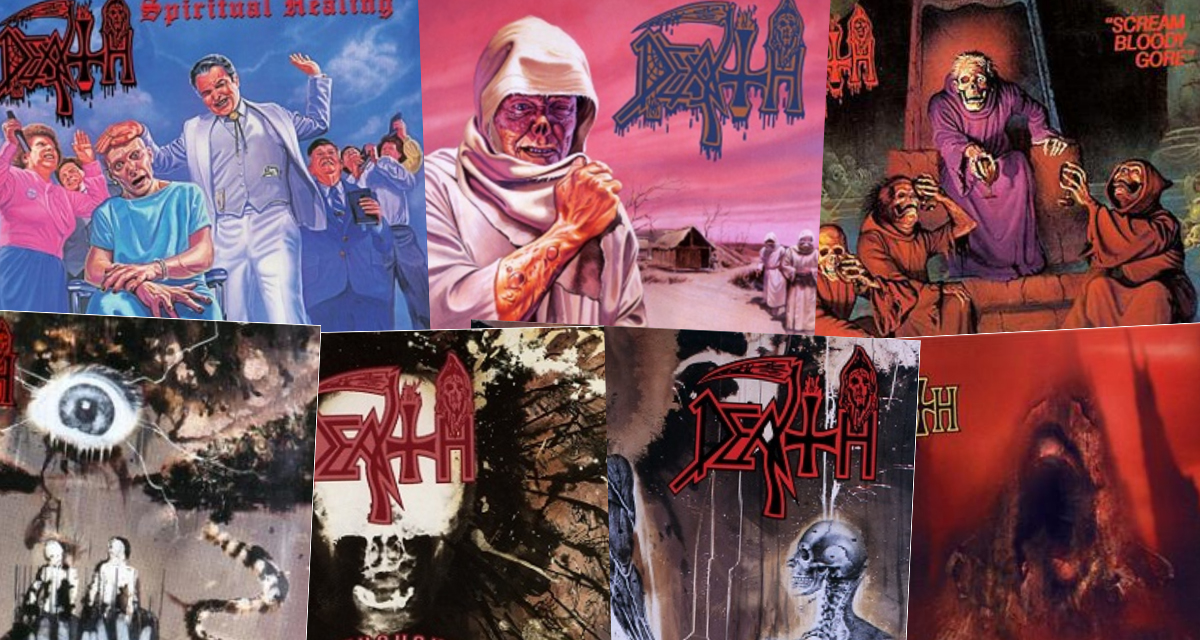Death metal is only called death metal because it sounds like the kind of metal Chuck Schuldiner invented (at an age when most of us were still trying to nail the first few bars of the “Sweet Child O’ Mine riff), and his band was called Death. There’s being influential, and then there’s having a vibrant and multifaceted subgenre literally named after your band.
Not many thrashy metal bands that rose to prominence in the ‘80s can claim never to have dropped at least one complete and utter dud in their career (looking at you, Metallica, Megadeth, Slayer, and Morbid Angel). But Death made seven albums, and they’re all good. Sadly, this is probably due in part to Chuck’s untimely, well, death in 2001. Maybe he eventually would have had a “Reload” or a “Risk” or a “Diabolus in Musica” or an “Illud Divinum Insanus” to share with the world too. But as it stands, he created one of the all-time most formidable metal discographies in just over a decade. So this is going to be a hard ranking. RIP, Chuck.
7. Spiritual Healing (1990)
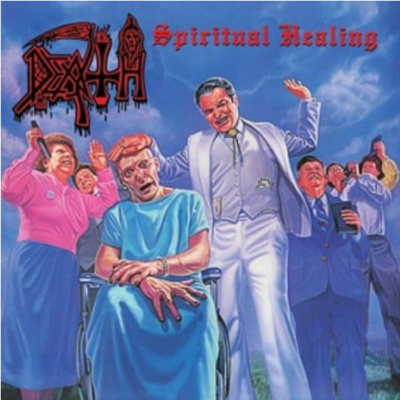 In a genre known for boundary-pushing album covers—Cannibal Corpse is only the tip of the iceberg on this—somehow this is among the most horrifying. What could be more grim than early ‘90s televangelism? The music is good, of course, with some especially killer drumwork, and an increased emphasis on melody, which, depending on what aspect of death metal you find most appealing, could be a good or bad thing. The riffing doesn’t seem quite as inspired or sinister as on the previous two albums, though admittedly, those albums were tough acts to follow. Also, there’s something weirdly off-putting about Chuck using a sexist slur on the opening track. We know, we know, it’s ridiculous to get prissy about mild profanity on a fucking death metal record, but it just comes off wrong.
In a genre known for boundary-pushing album covers—Cannibal Corpse is only the tip of the iceberg on this—somehow this is among the most horrifying. What could be more grim than early ‘90s televangelism? The music is good, of course, with some especially killer drumwork, and an increased emphasis on melody, which, depending on what aspect of death metal you find most appealing, could be a good or bad thing. The riffing doesn’t seem quite as inspired or sinister as on the previous two albums, though admittedly, those albums were tough acts to follow. Also, there’s something weirdly off-putting about Chuck using a sexist slur on the opening track. We know, we know, it’s ridiculous to get prissy about mild profanity on a fucking death metal record, but it just comes off wrong.
Play it Again: “Spiritual Healing” and “Killing Spree” (side B is really where it’s at on this one)
Skip It: “Living Monstrosity”
6. Human (1991)
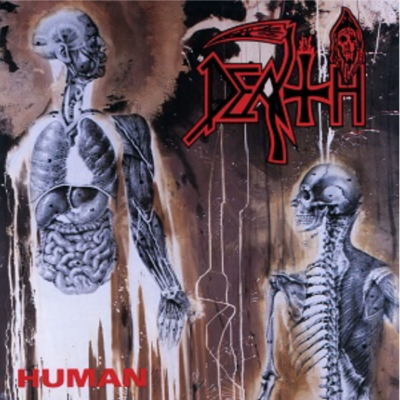 We’re pretty sure our readers are going to be cool with our bottom ranking, but we’re pretty sure we’re gonna get roasted on this one. This is a lot of people’s #1. It’s a perennial fan favorite. And it’s an important step toward Death becoming more technical and progressive, stylistic shifts that they’ll execute much more interestingly on subsequent albums. This one just doesn’t feel all that memorable or interesting by comparison. Darn good album? For sure. Top tier Death? Sorry, we just don’t see it.
We’re pretty sure our readers are going to be cool with our bottom ranking, but we’re pretty sure we’re gonna get roasted on this one. This is a lot of people’s #1. It’s a perennial fan favorite. And it’s an important step toward Death becoming more technical and progressive, stylistic shifts that they’ll execute much more interestingly on subsequent albums. This one just doesn’t feel all that memorable or interesting by comparison. Darn good album? For sure. Top tier Death? Sorry, we just don’t see it.
Play it Again: “Flattening of Emotions” and “Together as One.” This time, Side A is where it’s at.
Skip It: The cover of Kiss’ “God of Thunder.” Yeah, this is kind of cheating, because it was only on the Japanese import and then the 20th anniversary Relapse reissue. But like most things pertaining to Kiss that aren’t called “Detroit Rock City,” it is just SO skippable.
5. Symbolic (1995)
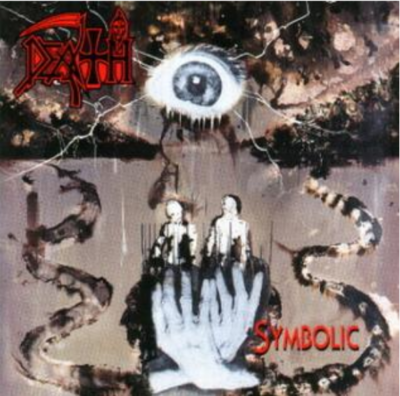 And the spicy takes continue. This is also a beloved Death album, but if we’re being honest with ourselves, aren’t they all? Is there a single one that doesn’t have its share of devotees ready to go to the mat for it? But then, isn’t that true of all art? Somewhere, there must be people who sincerely think “St. Anger” or “Illud Divinum Insanus” (yup, we’re gonna namecheck those trainwrecks twice) is the apex of artistic expression and audio engineering, right? What is art anyway, really, when you think about it? For that matter, what is art appreciation but the mere illusion that anything has an inherent aesthetic value at all? Have these ponderous questions sufficiently distracted you from the fact that we ranked “Symbolic” in the bottom half? Nope, guess not, y’all still look pretty pissed off. Shit.
And the spicy takes continue. This is also a beloved Death album, but if we’re being honest with ourselves, aren’t they all? Is there a single one that doesn’t have its share of devotees ready to go to the mat for it? But then, isn’t that true of all art? Somewhere, there must be people who sincerely think “St. Anger” or “Illud Divinum Insanus” (yup, we’re gonna namecheck those trainwrecks twice) is the apex of artistic expression and audio engineering, right? What is art anyway, really, when you think about it? For that matter, what is art appreciation but the mere illusion that anything has an inherent aesthetic value at all? Have these ponderous questions sufficiently distracted you from the fact that we ranked “Symbolic” in the bottom half? Nope, guess not, y’all still look pretty pissed off. Shit.
Play it Again: “Zero Tolerance” and “Empty Words”
Skip It: “Perennial Quest” – those harmonized guitars are verging on hair metal
4. Scream Bloody Gore (1987)
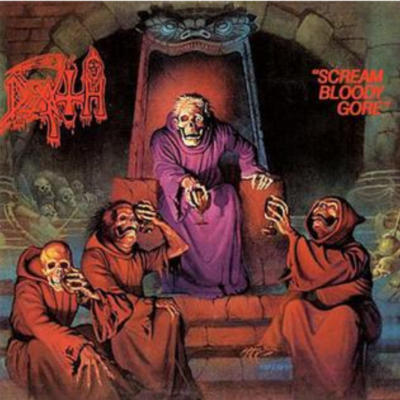 It’s the first Death studio album and also the first death metal album. Accept no substitutes. And if you’re a metalhead under the age of 50, just think of what a roundhouse kick to the face this album must have been if you’d been mainly listening to thrash and NWOBHM when you first picked this up. Surely, nothing could be heavier and/or more influential after the bar set by “Powerslave” and “Reign in Blood” and “Peace Sells” and “Master of Puppets” in the mid-’80s, right? Haha, nope, wrong. Pretend for a moment that you’re a 16-year-old kid who picked this thing up at your local record store on a whim: it starts off pleasantly enough, with a nice, slow groove to make you comfortable. Then Chuck comes in with the growling vocals and you’re like “OK, that’s different.” And then it just explodes into a whole new genre of music.
It’s the first Death studio album and also the first death metal album. Accept no substitutes. And if you’re a metalhead under the age of 50, just think of what a roundhouse kick to the face this album must have been if you’d been mainly listening to thrash and NWOBHM when you first picked this up. Surely, nothing could be heavier and/or more influential after the bar set by “Powerslave” and “Reign in Blood” and “Peace Sells” and “Master of Puppets” in the mid-’80s, right? Haha, nope, wrong. Pretend for a moment that you’re a 16-year-old kid who picked this thing up at your local record store on a whim: it starts off pleasantly enough, with a nice, slow groove to make you comfortable. Then Chuck comes in with the growling vocals and you’re like “OK, that’s different.” And then it just explodes into a whole new genre of music.
Play it Again: “Zombie Ritual” (that bass hook, omg) and “Denial of Life” and “Mutilation”
Skip It: “Regurgitated Guts”
3. The Sound of Perseverance (1998)
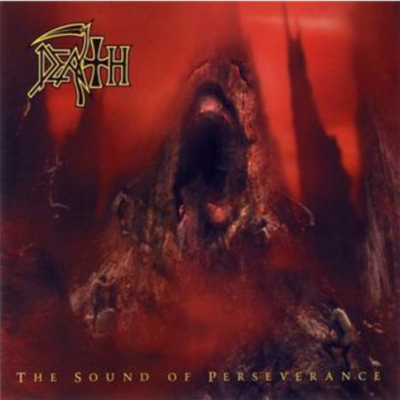 Do you like tempo shifts? Then this is probably your #1. “Sound of Perseverance” is Death’s most technical and prog-forward album, but the cool thing is that that doesn’t mean it sounds like Yes or King Crimson playing BC Rich guitars through a collection of HM-2 pedals, nor does it come across as wonky Gorgutsian theory-nerd stuff. There’s no barrier to entry on this in the way there is for a lot of bands’ more abstract and technical releases. This is just Death doing their thing: solid songwriting, in-your-face performance, and a rhythm section you could set your watch to. You can 100% dig it on that level. The musicianship here is top-notch, but in an understated and modest way, without the pretension and self-importance of metal at its techiest. Special acknowledgment must go to “Spirit Crusher,” a deceptively simple mid-tempo number in which Richard Christy nails one of the most weirdly inventive drum transitions imaginable.
Do you like tempo shifts? Then this is probably your #1. “Sound of Perseverance” is Death’s most technical and prog-forward album, but the cool thing is that that doesn’t mean it sounds like Yes or King Crimson playing BC Rich guitars through a collection of HM-2 pedals, nor does it come across as wonky Gorgutsian theory-nerd stuff. There’s no barrier to entry on this in the way there is for a lot of bands’ more abstract and technical releases. This is just Death doing their thing: solid songwriting, in-your-face performance, and a rhythm section you could set your watch to. You can 100% dig it on that level. The musicianship here is top-notch, but in an understated and modest way, without the pretension and self-importance of metal at its techiest. Special acknowledgment must go to “Spirit Crusher,” a deceptively simple mid-tempo number in which Richard Christy nails one of the most weirdly inventive drum transitions imaginable.
Play It Again: “Spirit Crusher” and “Flesh and the Power it Holds”
Skip It: “Painkiller”—the Kiss cover on Human is worse, to be fair, but Judas Priest just did not need to be invoked here either. It’s fun to play and listen to covers, but it’s an unnecessary way to close out such an epic album.
2. Leprosy (1988)
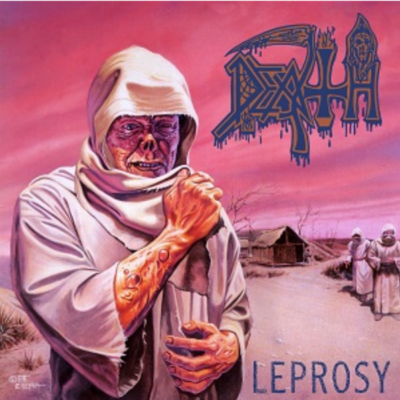 Released barely a year after the debut, it’s clear that with this album, Chuck & co. were bursting with ideas—not to mention an affinity for the kind of breakdowns that every deathcore band of the last ten years has homogenized into over-compressed sonic mush—and they channeled those ideas into this absolute monster of a death metal classic. Like a lot of the greats of the genre, their sophomore album pretty much leaves the thrash influence behind and fully embraces the burgeoning Floridian death metal/Morrisound aesthetic. Slightly more sophisticated than “Scream Bloody Gore” in terms of composition and production, but still so brutal and raw that it holds up with the heavyweights of the era like “Altars of Madness” and “Deicide.” When it comes to in-your-face aggression, those latter two might sound more evil and relentless, but “Leprosy” takes top honors for cohesiveness, an early step toward proggy technicality, and overall execution. Also, little known fact, it held the world record for “Pinkest Metal Album Art” for many years until it was finally beaten out by Deafheaven in 2013.
Released barely a year after the debut, it’s clear that with this album, Chuck & co. were bursting with ideas—not to mention an affinity for the kind of breakdowns that every deathcore band of the last ten years has homogenized into over-compressed sonic mush—and they channeled those ideas into this absolute monster of a death metal classic. Like a lot of the greats of the genre, their sophomore album pretty much leaves the thrash influence behind and fully embraces the burgeoning Floridian death metal/Morrisound aesthetic. Slightly more sophisticated than “Scream Bloody Gore” in terms of composition and production, but still so brutal and raw that it holds up with the heavyweights of the era like “Altars of Madness” and “Deicide.” When it comes to in-your-face aggression, those latter two might sound more evil and relentless, but “Leprosy” takes top honors for cohesiveness, an early step toward proggy technicality, and overall execution. Also, little known fact, it held the world record for “Pinkest Metal Album Art” for many years until it was finally beaten out by Deafheaven in 2013.
Play it Again: “Leprosy” and “Pull the Plug,” if we have to choose, but really all of it
Skip It: This is a tough one, but we’ll go with “Primitive Ways”
1. Individual Thought Patterns (1993)
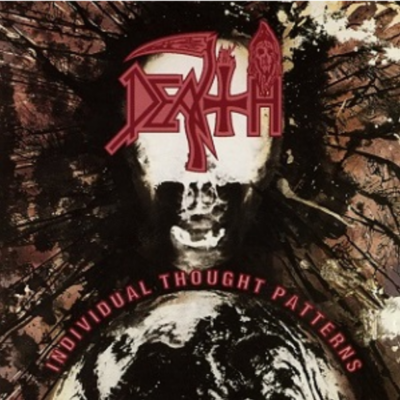 This one seems to fly under the radar sometimes, and we honestly think that might have something to do with the understated cover art. No dead-eyed lepers in a Mad Max wasteland or demonic mountaintops or “Tales from the Crypt”-style Halloween imagery or bug-eyed Evangelical lunatics committing elder abuse this time around. But never mind the album art (which is killer in its own right): this album is, to allude to a totally different sort of metal band, “more Human than Human.” Everything that made “Human” a triumph and a fan favorite—the flawless musicianship, the who’s-who-of-metal lineup, the jazz fusion flourishes, the stunning basswork, the thought-provoking lyrics—is even better on “Individual Thought Patterns.” Right out of the gate with album opener “Overactive Imagination,” this record goes from 0 to 100 in no time flat. This is basically Death’s “…and Justice for All.” It’s got a consistently satisfying “Harvester of Sorrow”-esque gallop, the lyrics are angry but poetic, the song structures are heavy as hell but deceptively intricate, and the bass could stand to be a tad higher in the mix. Oh, and like Justice, it’s the single best album in its band’s respective discography. We said what we said.
This one seems to fly under the radar sometimes, and we honestly think that might have something to do with the understated cover art. No dead-eyed lepers in a Mad Max wasteland or demonic mountaintops or “Tales from the Crypt”-style Halloween imagery or bug-eyed Evangelical lunatics committing elder abuse this time around. But never mind the album art (which is killer in its own right): this album is, to allude to a totally different sort of metal band, “more Human than Human.” Everything that made “Human” a triumph and a fan favorite—the flawless musicianship, the who’s-who-of-metal lineup, the jazz fusion flourishes, the stunning basswork, the thought-provoking lyrics—is even better on “Individual Thought Patterns.” Right out of the gate with album opener “Overactive Imagination,” this record goes from 0 to 100 in no time flat. This is basically Death’s “…and Justice for All.” It’s got a consistently satisfying “Harvester of Sorrow”-esque gallop, the lyrics are angry but poetic, the song structures are heavy as hell but deceptively intricate, and the bass could stand to be a tad higher in the mix. Oh, and like Justice, it’s the single best album in its band’s respective discography. We said what we said.
You could make a solid case for the other six Death albums being in literally any order (there are 720 different possibilities for that, if we’re remembering how to do factorials correctly from middle school math class, so go nuts), but we don’t see any world in which “Individual Thought Patterns” is NOT #1.
Play it Again: The first nine tracks, but especially the first two, “Overactive Imagination” and “In Human Form.” These are bangers of the highest order.
Skip it: Track 10, “The Philosopher.” Noted metal critics Beavis and Butthead mocked it pretty hard, and who are we to disagree with those two? (Actually, just kidding, we’re not taking music advice from someone in an AC/DC shirt, and this song also rips.)

